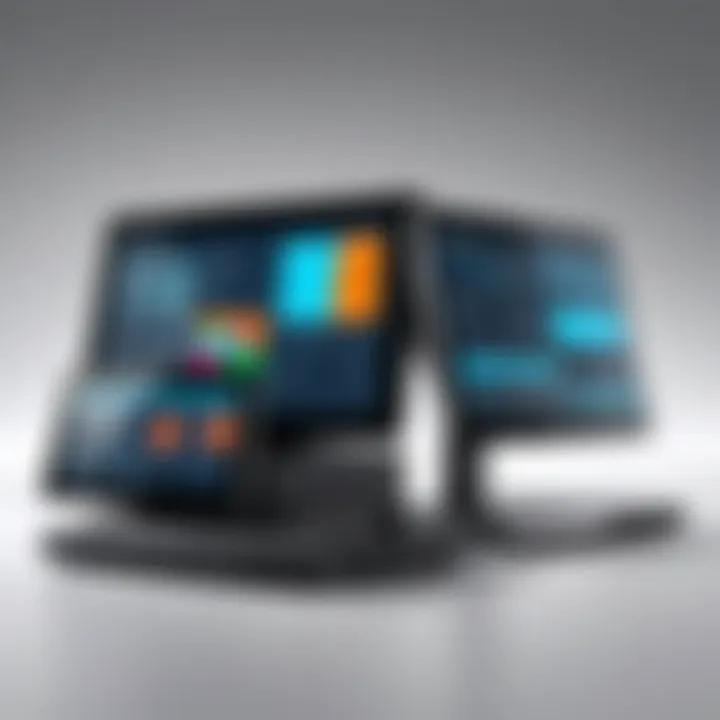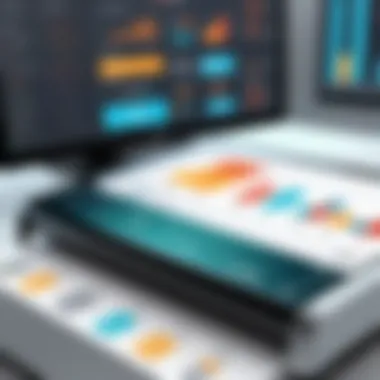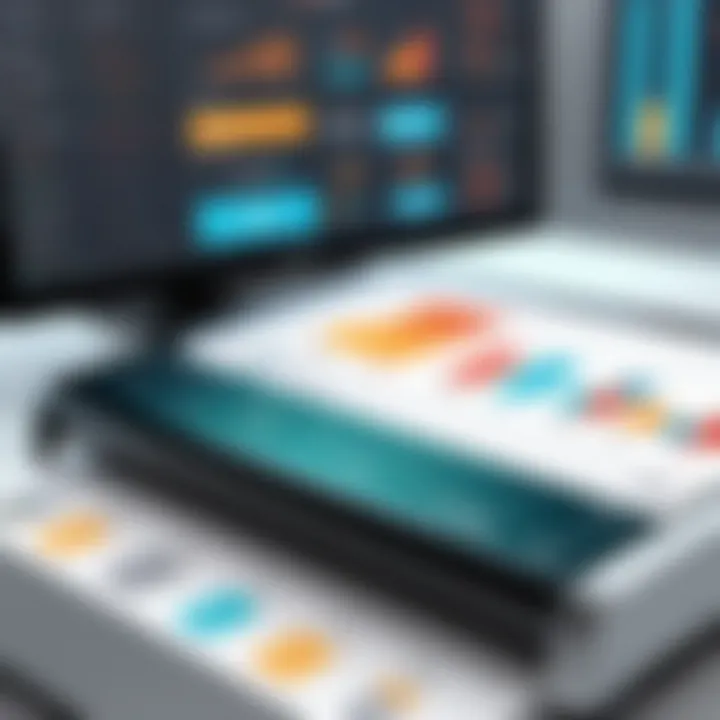Understanding the Financial Dynamics of POS Systems


Intro
In today's fast-paced retail environment, understanding the price of Point of Sale (POS) systems is essential for businesses aiming to enhance their operational efficiency. POS systems have evolved significantly, offering a broad range of functionalities that go well beyond basic transaction processing. The decision to invest in a POS system impacts not only immediate costs but also long-term financial outcomes. Thus, business professionals must consider various pricing structures, key features, and the potential return on investment (ROI).
This article aims to dissect the financial intricacies of POS systems. By examining the core features, user experience, and the various cost influencers, we create a framework that assists decision-makers in making informed purchases. The analysis provides insights to align POS functionalities with the specific needs of different businesses, further emphasizing the importance of making a strategic choice.
Overview of Core Features
Description of Essential Functionalities
A comprehensive POS system typically incorporates several core features. These capabilities are fundamental for streamlining business operations and include:
- Sales Processing: Efficiently handling transactions, managing payments, and providing receipts.
- Inventory Management: Tracking stock levels, managing suppliers, and setting re-order points to prevent stock-outs.
- Reporting and Analytics: Offering insights into sales performance and customer trends to make data-driven decisions.
- Customer Relationship Management: Storing customer information, purchase history, and preferences to enhance marketing efforts and customer service.
- Employee Management: Facilitating staff scheduling, attendance tracking, and performance evaluations.
These functionalities vary across different POS systems, and understanding which features are essential to your business is crucial for optimizing expenditures.
Comparison of Features Across Top Software Options
When evaluating POS systems, comparing features across different software options can shed light on which system offers the best value for your business. For example:
- Square POS may provide an all-in-one solution that is particularly beneficial for small businesses due to its user-friendly interface and transparent pricing.
- Shopify POS tends to favor e-commerce businesses looking to integrate online and offline sales seamlessly, offering robust inventory management features.
- Lightspeed offers advanced reporting capabilities preferable for larger retail outlets needing in-depth business insights.
These systems all carry unique price points, and their features play a substantial role in determining the overall cost.
User Experience and Interface
Insights into UI/UX Design Aspects
User experience (UX) is a critical factor when selecting a POS system. An intuitive user interface (UI) can significantly reduce training time for employees and enhance overall operational efficiency. Aspects to consider include:
- Ease of Use: The system should be straightforward for staff to navigate, minimizing time spent on transaction processing.
- Customization Options: The ability to tailor the interface based on the specific roles or preferences of users can improve the on-site experience.
- Multi-Device Compatibility: Many modern POS systems offer the flexibility of running across various devices such as tablets and smartphones, further enhancing user accessibility.
Importance of Usability and Accessibility
Usability directly impacts the effectiveness of the POS system in day-to-day operations. A highly usable POS provides:
- Fewer Errors: An intuitive design allows staff to execute transactions faster and with fewer mistakes.
- Higher Customer Satisfaction: Efficient processes lead to quicker service, creating a better overall customer experience.
- Adaptability for Growth: As businesses evolve, a POS system that emphasizes usability can adapt to new features or updates without overwhelming staff.
Such considerations are vital when contemplating the long-term viability and effectiveness of a POS system for any business.
A well-chosen POS system not only streamlines processes but also influences the business's financial trajectory over time.
As decision-makers delve into the pricing landscape of POS systems, these insights provide a framework for evaluating potential solutions that align with their operational goals.
Prelude to POS Systems
Understanding Point of Sale (POS) systems is crucial in the contemporary business landscape. These systems have evolved beyond simple cash registers. They now encompass software and hardware that facilitate transactions, inventory management, and customer relationship management.
Definition of POS Systems
A POS system refers to the combination of hardware and software that enables business transactions at a physical location. It typically includes components like a terminal, barcode scanner, receipt printer, and a digital interface for tracking sales and inventory. The software part processes payments, manages stock levels, and generates reports to help business owners understand their operations better.
Importance of POS Systems in Modern Business
The role of a POS system is integral in shaping how businesses operate today. With technology advancing, the efficiency and speed of service have become vital. This enables businesses to enhance customer satisfaction. A well-integrated POS system provides several benefits:


- Efficiency and Speed: Transactions complete faster, reducing customer wait times.
- Inventory Management: Businesses can track stock levels in real time, minimizing the risk of overstock or stockouts.
- Data Analytics: The system generates valuable insights into sales patterns that inform business decisions.
- Payment Flexibility: Modern systems support various payment methods including credit cards, digital wallets, and mobile payments.
In summary, a POS system is a foundational element in modern retail and service industries. Its integration allows businesses to streamline processes and adapt to an increasingly digital marketplace.
Price Considerations for POS Systems
Understanding the price of Point of Sale (POS) systems is crucial for businesses looking to optimize their operations. The costs associated with these systems often extend beyond the initial purchase, encompassing several elements that can significantly affect the total investment. Evaluating price considerations allows decision-makers to assess the financial viability of a POS solution in relation to their specific business needs. This understanding also aids in justifying the investment to key stakeholders.
Costs of Hardware Components
The hardware components of POS systems represent a significant portion of the total investment. The core hardware typically includes cash registers, tablets, barcode scanners, receipt printers, and card readers. Each element varies in price, depending on the brand and features.
For instance, traditional desktop registers might cost between $500 to $1500, while mobile tablets are usually more affordable at $300 to $800. Barcode scanners can range from $50 to $200. When selecting hardware, it is essential to consider not only the initial cost but also the longevity and reliability of the components. Higher-quality equipment often leads to lower long-term costs by minimizing failures and downtime.
Additionally, there are ancillary costs to consider, such as the expense of installation and training. It is wise to consult with vendors to obtain a comprehensive quote that captures all potential expenses upfront.
Software Licensing Fees
Software licensing fees vary widely based on the complexity of the POS system. Systems with more advanced features, such as integrated inventory management or analytics tools, generally command higher fees. Monthly subscriptions can range from as low as $50 for basic systems to several hundred dollars for advanced solutions. Choosing between a one-time fee and a subscription model can be challenging, as each has its own advantages and disadvantages.
When evaluating software costs, ensure that you factor in possible future upgrades. Certain software packages require additional fees for updates or new feature sets. It is prudent to analyze whether the software meets current and future needs before committing to a license.
"Selecting the right software is as crucial as choosing the hardware; they must work seamlessly together to maximize efficiency."
Maintenance and Support Expenses
Ongoing maintenance and support costs can also contribute to the overall pricing structure of POS systems. Most vendors offer support packages that cover technical assistance, software updates, and hardware repairs. These can be included in a subscription or available for an additional fee.
Average support contracts range from $200 to $500 annually, depending on the level of service. Failure to account for these expenses can lead to unexpected budget overruns. It is beneficial to examine the service level agreements (SLAs) to ensure that they meet the operational demands of the business.
Furthermore, consider investing in training for your staff. Proper training reduces errors and enhances productivity, leading to better customer service and, ultimately, a more significant return on investment.
Factors Influencing POS System Pricing
Understanding the pricing structure of POS systems is crucial for businesses aiming to make informed investment decisions. This section delves into the primary factors that can significantly affect the costs associated with POS systems. Each element provides insights into how businesses can tailor their POS choices to meet unique needs while optimizing their financial commitments. It is important to consider these factors carefully, as they can lead to either unnecessary expenditure or significant savings in the long run.
Business Size and Type
The size and type of business play a fundamental role in determining the overall cost of a POS system. Larger businesses, for instance, may need multiple terminals, which can drive up initial hardware costs. Conversely, a small retail shop might only require a single unit. The type of business also influences specific requirements, such as industry-compliant features, inventory management needs, and universal functionality.
- Retail businesses often demand more comprehensive inventory management features, which may lead to higher licensing fees.
- Restaurants may necessitate integrated payment options and table management settings, sometimes increasing the cost against traditional systems.
Understanding these different facets ensures that a business selects a system that aligns with its operational demands without incurring excessive costs.
Customization Needs
Customization is another vital factor that can dictate the price of a POS system. Many businesses operate with unique workflows, leading to the need for tailored solutions. Customization can involve various elements, including specific reporting capabilities or unique user interfaces.
- Off-the-shelf solutions generally come with lower costs but might lack functionality crucial for specific industries.
- Custom-built systems tend to rise in price, primarily if the development involves bespoke features designed to enhance efficiency or usability within that organization.
While customization can lead to higher upfront investment, it may ultimately improve process efficiency and result in cost savings over time.
Integrated Payment Options
The ability to accept various payment methods affects POS system pricing. Businesses today require systems capable of processing credit cards, mobile wallets, and other digital payment options.
- Systems that include built-in payment processing capabilities typically cost more than those requiring third-party integrations.
- Additional features, such as support for contactless payments, may increase costs but are becoming essential as consumer preferences shift.


Ensuring a seamless payment experience can enhance customer satisfaction, but businesses must weigh the potential costs against the expected benefits.
Number of Users
The number of users accessing the POS system directly influences the cost structure. Systems often operate on a per-user pricing model, meaning businesses with multiple employees accessing the same system will incur higher fees.
- Systems priced per terminal or per location can lead to significant savings for smaller businesses.
- Conversely, businesses anticipating growth should consider scalable solutions that can accommodate increased user access without exorbitant fees in the long term.
Understanding this aspect aids businesses in selecting a system that not only meets current needs but will also support future growth without disproportionate spending.
Types of POS Systems and Their Costs
Understanding the different types of POS systems and their costs is essential for businesses evaluating options. The variety of systems available can address specific operational needs, thereby impacting the overall efficiency and profitability of a business. Often, the best choice depends on the nature of the business and its size.
Traditional POS Systems
Traditional POS systems are typically hardware-based and have been around for many years. They include physical touchscreens, cash registers, barcode scanners, and receipt printers. These systems are commonly used in retail stores and restaurants. Often, they require a significant upfront investment.
Key points to consider with traditional POS systems include:
- Cost of Hardware: This includes the purchase of terminals, peripherals, and any associated hardware.
- Software Costs: Many traditional systems come with one-time fees for the software, which may not include future updates or upgrades.
- Maintenance: Companies must also consider potential costs for service or repair.
While traditional systems offer advantages, such as a high level of reliability and dedicated customer support, they may not offer the flexibility that modern businesses require.
Mobile POS Systems
Mobile POS systems are gaining popularity mainly due to their convenience and flexibility. These systems operate on mobile devices such as tablets or smartphones, using apps to process transactions. Businesses can accept payments on the go, which is especially beneficial for markets or pop-up shops.
Considerations for mobile POS systems involve:
- Initial Purchase: While often less expensive than traditional systems, costs for devices like tablets can still add up.
- Subscription Fees: Many mobile POS solutions adopt a subscription pricing model, charging monthly or transaction-based fees.
- Integration: Companies might need additional interfaces or adapters for payments, which can also incur extra costs.
Mobile POS systems may offer a lower barrier to entry but come with ongoing costs associated with software licensing and potential hardware updates.
Cloud-Based POS Solutions
Cloud-based POS systems deliver a cutting-edge alternative to traditional models. These systems rely on internet connectivity, which allows businesses to access their data and manage sales from virtually anywhere. This adaptability is particularly useful for businesses managing multiple locations.
Points to examine in cloud-based POS systems are:
- Cost Structure: Often, cloud systems are subscription-based, leading to predictable monthly fees without the need for hefty upfront investments.
- Scalability: As a business grows, it can often add more features easily without significant costs.
- Data Security: Cloud services handle updates and backups, ensuring businesses are protected from data loss.
In summary, while cloud-based systems may involve ongoing subscription costs, they offer flexibility and scalability that traditional systems may not provide.
Understanding the cost structures of different POS systems allows decision-makers to align their investment with the operational needs of their businesses.
Choosing the right POS system requires thorough evaluation of each type's costs and benefits. Consider what best fits your operational model to make an informed decision.
Long-Term Investment and ROI of POS Systems
Investing in a Point of Sale (POS) system can seem daunting. However, understanding its long-term value is essential for businesses. A POS system is not just a one-time purchase; it is an investment that can yield significant returns over time. Decision-makers should evaluate the costs and benefits carefully. They need to look beyond the initial price tags to understand the full scope of potential returns.
Calculating Return on Investment
To grasp the return on investment (ROI) of a POS system, start with a straightforward calculation:


In this equation, gains can come from various sources, including:
- Increased Sales: A faster checkout process enables more customers to be served.
- Operational Efficiency: Automation reduces manual errors, saving time and resources.
- Better Inventory Management: Improved tracking leads to minimized losses.
- Customer Insights: Data analytics can inform marketing strategies, driving revenue growth.
Focusing on these elements helps businesses realize that the investment in POS systems pays off. It is also important to remember that ROI is not always immediate. Some benefits may accrue over time, impacting long-term revenue positively.
Benefits Beyond Price
While the initial cost of a POS system is an important factor, there are many benefits that extend beyond just price. Listed below are some critical advantages:
- Increased Customer Satisfaction: A more efficient checkout process leads to happier customers, potentially boosting repeat business.
- Enhanced Data Security: Many modern POS systems come with robust security features that protect sensitive customer information.
- Scalability: Businesses can adapt their systems as they grow. Many providers offer solutions that grow with your company.
- Integration Capabilities: Easy integration with other tools such as accounting or inventory systems can streamline operations.
Investing in a POS system is about creating a tool that facilitates long-term growth and efficiency for your business.
As such, while price is one metric to consider, the long-term benefits often outweigh initial costs. Evaluating these factors holistically provides a clearer picture of the overall value of a POS system in relation to its pricing.
Case Studies: Price versus Features
Understanding the relationship between price and features in POS systems is crucial for businesses aiming to optimize their investments. This section delves into real-world examples, illustrating how different sectors approach POS system selection based on cost and functionality. By examining these case studies, business decision-makers can gain insight into the practical implications of choosing a POS system that suits their specific needs while balancing budget considerations.
The significance of analyzing case studies lies in the ability to identify patterns and expectations within different industries. Each sector has its unique requirements, and the POS system must reflect those needs. For decision-makers, understanding how specific features justify their costs can lead to more informed choices.
Retail Sector Examples
In the retail industry, the selection of a POS system often revolves around two primary concerns: managing inventory and enhancing customer experience. Retailers typically seek systems that provide seamless integration with inventory management and customer relationship management tools. For instance, a well-known retail chain adopted the Square POS system for its simplicity and cost-effectiveness. They desired an affordable solution that still offered essential features like sales reporting and inventory tracking. The cost of their annual subscription was outweighed by the increased sales, which they attributed directly to better inventory management through real-time analytics provided by their POS system.
A Harvard Business Review study highlights that companies prioritizing features aligned with their strategic goals often reported higher customer satisfaction ratings. Retailers who choose more advanced systems, such as Vend or Clover, may incur higher fees but usually access features like advanced analytics and customizable loyalty programs. Thus, evaluating whether the additional features justify the price becomes paramount.
Hospitality Industry Insights
The hospitality sector presents another fascinating case where price versus features plays a critical role. Here, POS systems facilitate not just sales but also reservations, table management, and staff scheduling. A prime example is a mid-range restaurant’s transition to Toast POS. The restaurant aimed to enhance customer experience and streamline operations. Although the upfront costs were significant, the result was a noticeable increase in order accuracy and a decrease in table turnover time. Customers were served faster, leading to increased repeat business and overall profitability.
A report from Restaurant Technology Network suggests that restaurants embracing integrated POS systems often see a 20% increase in operational efficiency. Investing in a feature-rich POS solution can be less about initial outlay and more concerned with long-term profitability. Thus, restaurants showing a commitment to quality through their choice of POS feature significantly impact their service level and guest satisfaction.
Future Trends in POS Pricing
The landscape of Point of Sale systems is continually evolving, influenced by emerging technologies and shifting market demands. Understanding the future trends in POS pricing is essential for businesses looking to make strategic investments. Companies need to anticipate changes that may affect not just the price but also the features and functionalities relevant to their operations. This section highlights key elements such as the adoption of subscription models and the impact of innovative technologies, providing valuable insights for decision-makers.
Adoption of Subscription Models
Subscription models have gained traction as businesses seek more flexible payment structures. Rather than a large upfront cost, companies can opt for monthly or annual payments for POS systems. This approach allows businesses, especially startups and smaller enterprises, to manage cash flow more effectively.
- Fixed Monthly Costs: Subscription pricing offers predictability, as businesses know their expenses for the system each month. This can be helpful in budgeting and financial planning.
- Regular Updates: Many subscription-based services include software upgrades as part of the package, which reduces the cost and hassle of maintaining up-to-date systems.
- Scalability: As business needs evolve, subscription models can easily accommodate growth. Companies can adjust their services and payment plans based on fluctuations in demand.
However, businesses must consider potential long-term costs. Over several years, subscription fees can accumulate, and it may lead to a higher total expense compared to traditional purchase models. Each business should analyze their unique needs before deciding.
Emerging Technologies Impacting Prices
Technological advancements are reshaping the pricing structure for POS systems. Innovations such as artificial intelligence, mobile payment solutions, and cloud computing are significant in transforming the industry.
- Artificial Intelligence: AI enables smarter inventory management and customer relationship management. While these advanced features may increase initial pricing, they can result in substantial efficiency gains and cost savings in the long run.
- Mobile Payment Integration: As consumers prefer mobile transactions, POS systems that incorporate mobile payment options may command higher prices. Yet, these features enhance customer experience and can lead to increased sales.
- Cloud-Based Systems: Cloud computing allows for lower hardware costs and easier scalability. Instead of investing in expensive on-site equipment, businesses can use affordable cloud solutions, changing the financial landscape.
Overall, businesses must stay informed about these emerging technologies. The willingness to adapt to these trends can significantly impact both pricing and operational efficiency. Staying ahead of these shifts is critical for maximizing the return on investment.
"Businesses that harness the potential of emerging technology will find themselves not just surviving but thriving amid change."
By embracing these trends, organizations can create more efficient systems that align with their needs and customer expectations. Understanding the interplay between pricing, technology, and business strategy is essential for making informed decisions that lead to growth.
Closure
Summarizing Key Takeaways
- Comprehensive Cost Evaluation: The financial aspects of POS systems involve more than just the upfront price. Businesses should consider hardware, software, maintenance, and support costs.
- Customization and Needs: Different businesses require different types of systems. Analyzing what features are essential can help narrow down the options and potentially save money.
- Integration Aspects: The ability of a POS system to integrate with existing technology can impact the overall costs. More integrations may mean higher upfront costs but could increase efficiency long-term.
- Investment Perspective: Viewing a POS system as a long-term investment rather than a mere expense can change the decision-making process. The potential return on investment is vital for justifying the initial outlay.
- Future-Proofing: As technology evolves, selecting a versatile system that can adapt to trends is advantageous. This consideration may mitigate future financial risks often associated with technological obsolescence.



